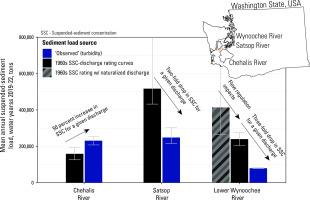华盛顿州西南部改善土地利用后河流悬浮沉积物浓度的不同趋势
IF 3.1
2区 地球科学
Q2 GEOGRAPHY, PHYSICAL
引用次数: 0
摘要
人们普遍认为,自20世纪中叶以来,伐木作业的改进减少了太平洋西北部河流中的悬浮沉积物负荷。然而,很少有机会直接评估这一点,特别是在较大的河流中。我们比较了华盛顿州西部三个具有相似土地利用历史的大型、积极管理的流域的现代(2019-22)和历史(20世纪60年代)悬浮沉积物监测。在南奥林匹克山脉的两个流域(萨索普河和怀努奇河),现代的沉积物产量约为300吨/平方公里/年,比历史条件低两到三倍。从这些流域流出的大部分悬浮沉积物来自下游流域被冰川沉积物覆盖的起伏地形,而不是陡峭的上游。切哈利斯河(Chehalis River)的现代沉积物产生量较低(70吨/平方公里/年),尽管与历史条件相比增加了50%。从1961年到1994年,Chehalis河的ssc -流量关系是稳定的,表明这种增加发生在1994年之后的某个时间。在2007年的一场风暴中,切哈利斯河的源头受到了独特的滑坡影响,尽管有一些证据表明那场风暴不是最近滑坡增加的原因。最终,改善的土地利用做法似乎使南奥林匹克山脉大型河流的悬浮泥沙负荷减少了几倍,这与之前在西奥林匹克山脉的发现一致,主要是由于下游流域的泥沙输送减少了。切哈利斯河的ssc排放趋势和较低的产量强调了背景沉积物输送率和对土地利用干扰的敏感性在一个区域内可能有很大差异。本文章由计算机程序翻译,如有差异,请以英文原文为准。

Divergent trends in fluvial suspended-sediment concentrations following improved land-use practices, southwest Washington State
Improvements in logging practices since the mid-20th century are widely presumed to have reduced suspended sediment loads in streams across the Pacific Northwest. However, there have been few opportunities to directly assess this, particularly in larger rivers. We compare modern (2019–22) and historical (1960s) suspended sediment monitoring in three large, actively managed watersheds in western Washington with similar land-use histories. In the two watersheds draining the southern Olympic Mountains (Satsop and Wynoochee Rivers), modern sediment yields were around 300 t/km2/yr, two to three times lower than historical conditions. Most suspended sediment exiting these watersheds came from rolling terrain mantled by glacial deposits in the lower watersheds, not the steep headwaters. Modern sediment yields in the Chehalis River, draining the low-relief Willapa Hills, were lower (70 t/km2/yr), though this represented a 50 % increase relative to historical conditions. SSC-discharge relations in the Chehalis River were steady from 1961 to 1994, indicating this increase happened sometime after 1994. The Chehalis River headwaters were uniquely impacted by landsliding during a 2007 storm, though there is some evidence against that storm as the cause of the recent increase. Ultimately, improved land-use practices appear to have reduced suspended sediment loads in large rivers of the southern Olympic Mountains several-fold, consistent with prior findings in the western Olympic Mountains, primarily due to reduced sediment delivery from the lower watersheds. Countervailing SSC-discharge trends and lower yields in the Chehalis River underscore that background sediment delivery rates and sensitivity to land-use disturbance may vary substantially within a region.
求助全文
通过发布文献求助,成功后即可免费获取论文全文。
去求助
来源期刊

Geomorphology
地学-地球科学综合
CiteScore
8.00
自引率
10.30%
发文量
309
审稿时长
3.4 months
期刊介绍:
Our journal''s scope includes geomorphic themes of: tectonics and regional structure; glacial processes and landforms; fluvial sequences, Quaternary environmental change and dating; fluvial processes and landforms; mass movement, slopes and periglacial processes; hillslopes and soil erosion; weathering, karst and soils; aeolian processes and landforms, coastal dunes and arid environments; coastal and marine processes, estuaries and lakes; modelling, theoretical and quantitative geomorphology; DEM, GIS and remote sensing methods and applications; hazards, applied and planetary geomorphology; and volcanics.
 求助内容:
求助内容: 应助结果提醒方式:
应助结果提醒方式:


